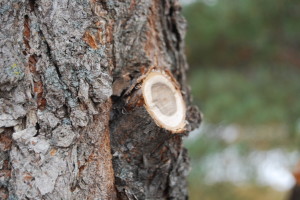At this time of year we get a fair number of calls to our office from people who wonder “is it to late to prune my trees?”. When discussing the timing of pruning, it is important to consider both the age of the plant as well as the season of pruning. Age of the plant dictates factors such as what type of pruning should be done, how much material can or should be removed and where specific cuts should be made. The time of year has an effect on the direction and quantity of resulting growth. We can also have an effect on the plants health by pruning at specific times.
Seasonal Timing
Although some thought should be given to the species of the tree, seasonal timing should be more about what results you hope to gain through your pruning. For instance, pruning in the dormant season (winter) tends to produce a flush of growth in the spring. Where as pruning in late summer tends not to produce these results.
As a rule, spring and fall are seasons to avoid when pruning. This is because there are so many other physiological processes occurring at these times. Pruning causes wounds that the tree has to deal with, and it is not best equipped to deal with them when it is trying to produce or drop leaves and flowers.
Winter Pruning
Winter is often the best time to prune your trees. This is because energy levels in the branches of the plant you are pruning are at their lowest. When the tree drops it’s leaves, it also packs energy into the trunk and roots. This allows the energy to be directed into the branches that remain, leading to extra growth. There is also reduced risk of insect or disease infestation as the pests are just not active in the winter. This eliminates a major concern of spring and summer pruning.
Certain species of trees should only be pruned a certain times of year. For instance, Elms should only be pruned in the dormant season between October 1st and March 31st annually. This is to reduce the chance of infection by Dutch Elm disease. Birches should only be pruned in the Summer as it reduces any chance of sap “bleeding” from the cuts and staining the bark of the tree. An ISA Certified Arborist should be able to help you decide when to prune any of your trees and shrubs. If you are unsure, don’t hesitate to contact us.
Start Pruning Early
Another important factor to consider is the age of the tree being pruned and when the best time to prune during its lifespan. The earlier you start, the fewer problems there will be down the road. Young and juvenile trees are in a better condition for responding to the cuts being made. Less material should be removed from older more mature trees as they have a much tougher time moving the energy and water required to help with the “healing” of pruning wounds.
When considering pruning any tree, it is important that you know how to make the proper cuts. If you are unsure how this is done it would be best to contact a professional.




Excellent article on tree pruning. I have a huge saskatoon tree in my backyard and have been pruning it over back for years because the previous owners let it grow wild. I assume from the article that if I want to prune it back again this year I should get it done asap before spring growth starts?
As an aside, what type of chainsaws do you use? I run a site that gives advice for people looking to buy chainsaws and would love to hear your opinion on brands and such.
Hi. I found your website and wondered if you would be able to help me out. I am from south east Saskatchewan with a 3/4 year old yard. We have pruned out trees in the past. Wondering if now is an ok time to prune our poplars and our green ash. I noticed the green ash were a little slow to grow there leaves last year after pruning. I know it was the pruning that slowed their growth because the ones I didn’t prune produced leaves about a week or two earlier than the ones that I did prune.
I was wondering if you could give me a date range of the best times to prune my trees.
We have the following on our yard:
Hybrid poplar
Green Ash
Sundance Poplar
Caragana
Willow – weeping, silver, Laurel Leaf, Red willow (red new growth, not sure the exact name)
Thunderchild crabapple
Apple trees
Lilacs
Is there such a thing as too soon in the winter (can you prune when its -20?)?
Thank you for your help!
Hello Chelsea, Winter is a good time to prune any of these species you listed. The dormant season runs from when trees drop their leaves in the Fall until the following Spring when water and nutrients start to push back out from the roots into the crowns of the trees. This usually happens in late April/early May. Dormant pruning should occur before the trees start to push this energy up. There should be no issue for the trees if they are pruned while it is -20c or even -30c, but it can be hard on the person doing the pruning! So to put it simply, any of your trees can be pruned annually from November 1st thru March 31st annually without issue. We usually avoid the period while the leaves are forming in the Spring and when they turn color and fall off in the Fall. Pruning during the mid-summer is usually safe as well but the dormant season is optimal.
I hope this helps… Please let us know if you have any further questions!
Thank you so much for your help Matt. This really eases my mind!
Hello,
I have a silver poplar in my perennial bed in my back yard. I am located in Winnipeg, MB and it is currently about 68 F outside.
It is shaped almost like a claw if that makes sense, where the branches go up almost in a claw/bowl shape from the ground.
It has grown so large and has taken over my garden but I’ve been afraid to cut too much off of it. I can see it blowing when it’s really windy and I’m worried the branches are going to snap.
When would you say I am safe to heavily prune this tree? Should I be waiting until it’s actually winter or would it harm it to do it sooner?
Thanks in advance!
Hi Jessica,
We would recommend contacting an ISA Certified Arborist to discuss the type and timing of the pruning you are enquiring about. You can find a list of ISA Certified Arborists in your area at this link: Manitoba ISA Certified Arborists